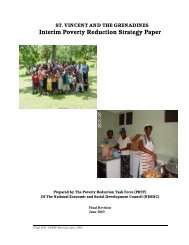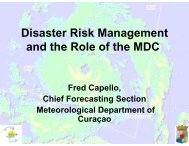The Anatomy of A Silent Crisis The Anatomy of A Silent Crisis
The Anatomy of A Silent Crisis The Anatomy of A Silent Crisis
The Anatomy of A Silent Crisis The Anatomy of A Silent Crisis
- TAGS
- anatomy
- www.bb.undp.org
You also want an ePaper? Increase the reach of your titles
YUMPU automatically turns print PDFs into web optimized ePapers that Google loves.
108 Forum 2009: Climate Change – <strong>The</strong> <strong>Anatomy</strong> <strong>of</strong> a <strong>Silent</strong> <strong>Crisis</strong><br />
188. International Strategy for Disaster Reduction<br />
Statistics, (2009). 2008 values.<br />
189. 1998-2007 values based on Munich Re and PIK<br />
(2008).<br />
190. <strong>The</strong> CGAP Working Group on Microinsurance on<br />
behalf <strong>of</strong> the International Labour Organization<br />
(ILO) defines “breadwinners” as the members <strong>of</strong><br />
households who earn all or most <strong>of</strong> the income.<br />
191. Results from updated Stern model (PAGE 2002) when<br />
equity weights were applied to correct for income<br />
differentials between developed and the developing<br />
nations. See “Notes on report methodology D.” for<br />
further description.<br />
192. International Strategy for Disaster Reduction<br />
Statistics, (2008) and Centre for Research on the<br />
Epidemiology <strong>of</strong> Disasters Database, (2009).<br />
193. Off, G. (2008): “A look at the victims <strong>of</strong> Hurricane<br />
Katrina.” Scripps Howard News Service. February 20.<br />
http://www.scrippsnews.com/node/30868.<br />
194. Irish Aid. (2009): “What is Gender Equality?” Irish Aid<br />
Volunteering and Information Centre. http://www.irishaid.<br />
gov.ie/Uploads/Gender%20Inequality%20flyer.pdf.<br />
195. IUCN. (2004): Energy: Gender Makes the Difference.<br />
IUCN.<br />
196. Aguilar, L. (2007): “Gender differences in deaths from<br />
natural disasters are directly linked to women’s social<br />
and economic rights.” Women’s Manifesto on Climate<br />
Change, UN Commission on the Status <strong>of</strong> Women.<br />
51st Session. Emerging Issues Panel: Gender<br />
Perspectives on Climate Change.<br />
197. Oxfam Canada. (2009): “Climate Change.” Oxfam<br />
Canada. http://www.oxfam.ca/what-we-do/themesand-issues/climate-change/#_edn1.<br />
198. GenderAction. (2009): “Doubling the Damage: World<br />
Bank Climate Investment Funds Undermine Climate<br />
and Gender Justice.” GenderAction. http://www.<br />
genderaction.org/images/2009.02_Doubling%20<br />
Damage_AR.pdf.<br />
199. Millennium Development Goals Indicators Statistics,<br />
(2009). 2004 values.<br />
200. Millennium Development Goals Indicators Statistics,<br />
(2009), 1994-2004 values.<br />
201. UN. (2009): “List <strong>of</strong> Least Developed Countries.”<br />
UN Office <strong>of</strong> the High Representative for the Least<br />
Developed Countries, Landlocked Developing<br />
Countries and Small Island Developing States. http://<br />
www.un.org/special-rep/ohrlls/ldc/list.htm<br />
202. Millennium Development Goals Indicators Statistics,<br />
(2009). 2004 values and Maplecr<strong>of</strong>t, (2009).<br />
203. US EPA. (2009): “Human-Related Sources and Sinks<br />
<strong>of</strong> Carbon Dioxide.” US Environmental Protection<br />
Agency. http://www.epa.gov/climatechange/<br />
emissions/co2_human.html, NEAA. (2009): “Global<br />
carbon dioxide emissions, 1970-2001.” Netherlands<br />
Environmental Assessment Agency. http://www.mnp.<br />
nl/mnc/i-en-0166.html and Pew. (2009): “Coal and<br />
Climate Change Facts.” Pew Center on Global Climate<br />
Change. http://www.pewclimate.org/global-warmingbasics/coalfacts.cfm.<br />
204. Howden, D. (2007): “Deforestation: <strong>The</strong> hidden cause<br />
<strong>of</strong> global warming.” UK Independent. http://www.<br />
independent.co.uk/environment/climate-change/<br />
deforestation-the-hidden-cause-<strong>of</strong>-global-warming-<br />
448734.html.<br />
205. Bi<strong>of</strong>uels are produced from biological materials like<br />
corn and are different from fossil fuels like oil made<br />
from long dead biological substances.<br />
206. Hance, J. (2008): “Tropical deforestation is ‘one <strong>of</strong><br />
the worst crises since we came out <strong>of</strong> our caves’ .”<br />
Mongabay. http://news.mongabay.com/2008/0515hance_myers.html.<br />
207. University <strong>of</strong> Michigan. (2006): “Global Deforestation.”<br />
University <strong>of</strong> Michigan, Lecture on January 4. http://<br />
www.globalchange.umich.edu/globalchange2/<br />
current/lectures/deforest/deforest.html.<br />
208. Approximately 57% <strong>of</strong> forest cover is located in<br />
developing nations, while 43% is in developed countries<br />
according to FAO. UNEP. (2007): “Forest loss.” United<br />
Nations system-wide earth watch. http://earthwatch.<br />
unep.ch/emergingissues/forests/forestloss.php.







